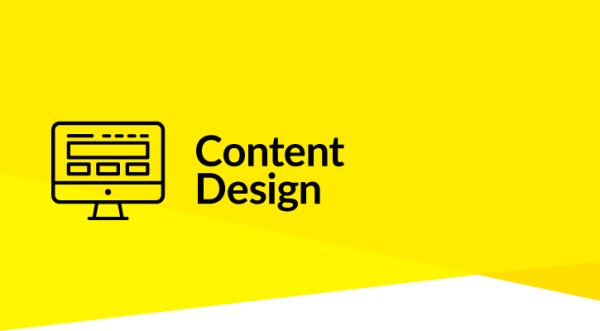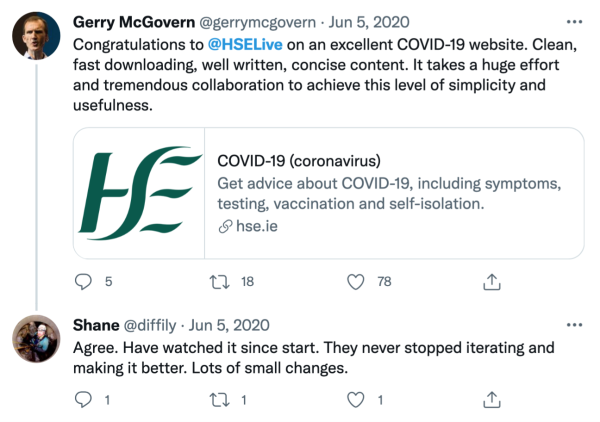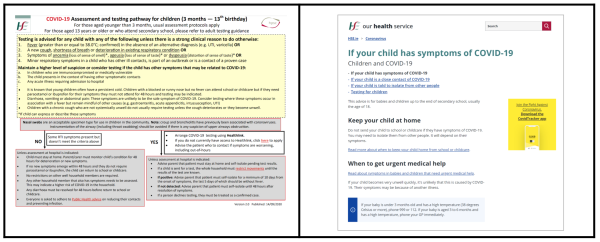Brian Malone and Steve Cummins, Content Design Team

Seeing your work up in lights and promoted to thousands of commuters is something most of us humble content designers don't expect to see. Yet in March 2020, there it was – the fruits of our team's work filtered out to thousands of commuters on motorways as everyone in Ireland scrambled for urgent advice on how to protect themselves and their family from COVID-19.

Above: A motorway sign on the M7 (Credit: Leinster Leader/KildareNow)
At the very start, we were scrambling too, but thanks to partnerships with Public Health, the Health Protection Surveillance Centre (HPSC) and other parts of the HSE we were able to rapidly deliver accurate and easy to understand content to hopefully help ease our users' stress and worry.
So how did we do it? The main things that stand out from the benefit of 18 months of hindsight are:
- our existing guidelines – we had great ones in place – see below how this enabled us to work quickly
- iteration – we had tools and practices that helped us continuously improve
- partnerships with experts
- skilled team who pulled together in extraordinary circumstances
Existing guidelines
Our existing guidelines helped us to make decisions quickly while still working to a high standard.
For example, the HSE’s Digital Roadmap divides our content across separate websites for each of our audience groups – one for the public, one for staff and one for healthcare professionals. Before any content was published, we discussed and agreed that HSE.ie would be the go-to place for public information on COVID-19, while HPSC.ie would provide content for professionals. Our staff website (healthservice.hse.ie) would service HSE staff and the News Features section of HSE.ie would be the space for organisational updates and stakeholder content.
Documenting this and agreeing to it early on was key. It meant that everyone was able to focus on what their users needed and we could cut out some unnecessary duplication of information that might have confused people.
Some other standard practices we followed include:
- peer review of all content by other content designers before publishing
- using data and evidence to inform our decisions - for example, checking what people are searching for and what words they use
- working to a reading age of 9 years, up to a maximum of 12 for some medical content
- using good titles and headers to differentiate content and help users to scan easily
- not relying on PDFs to provide important public messages – content on HTML web pages offers the best experience
Continuous improvement
The COVID-19 landing page was the most viewed page in 2020, with 8.5 million views. To put this into context, the most viewed page in 2019 was the HSE.ie job search page with 2.7 million views.

Above: Monthly visits to the COVID-19 content on HSE.ie in 2020
With such a huge audience of users, including many people who were sick or worried, we took every opportunity to make our content the best it could be. Here are some techniques we used:
Content crits
For these sessions we bring all our content designers to critique some content. We’re always clear that we’re critiquing the work, not the content designer. We review it individually. We then regroup to discuss our notes and make changes as we go or mark things for expert input if needed.
Getting a full team of feedback on content is especially helpful for complicated pieces of content. We always come out the far side with a significantly improved piece of content. Finding time for these sessions can be hard but they’re always worthwhile.
User feedback reviews
At the bottom of every web page we ask users if they found what they were looking for. If a user says ‘Yes’, we ask them for some additional feedback. If a user says ‘No’, we ask what we can do to improve.
In the early days of the pandemic, as new information was emerging rapidly, we reviewed in-page user feedback every day. This feedback was incredibly helpful in showing us weak spots in content.
Sometimes, simply adding a prominent link to a related page was enough to solve a problem for people and improve user satisfaction rates. Other times, the feedback told us people were confused about particular pieces of information meaning we needed to find a way to make it clearer.
Content testing
We’re still experimenting with different content testing methods. It’s a less well established type of testing than some others (like website usability testing) but we’re becoming clearer about what works well and what doesn’t.
One thing that worked well, especially given our need to run testing remotely, was to use instant messaging and online documents to facilitate testing sessions.
We did this for a number of pages related to COVID-19 and children and the results helped us to identify problem areas and challenge some of our own assumptions by putting it to the test with real users.

Above: Tweets congratulating HSE on the COVID-19 website and acknowledging the iterative approach we took.
Partnerships, fact checking and alignment
Making sure our COVID-19 content was correct and up-to-date was crucial but challenging at times with frequent, and sometimes sudden, changes in information and a broader ecosystem of information providers on various channels across the HSE and other organisations.
By partnering with subject matter experts (public health doctors, GPs, clinical leads) who were responsible for factual accuracy, we could apply our content design skills to take more complicated information and formats and simplify it without losing meaning.
For example, on the left below you can see a medical algorithm on the COVID-19 assessment and testing pathway for children. While this is accurate and may work well for people used to reading in this way, this format may require a bit more effort by users It could be tricky to extract the advice that is relevant to them and be certain they’ve understood it correctly. It’s also a PDF which means it’s less accessible to people using assistive technologies and doesn’t work as well in search engines.

Above left: Algorithm explaining the pathways for assessing and testing children. Above right: Content to explain the pathway to parents
As source content, the algorithm was a great basis for the content on the right which was created using content design principles to help parents know what to do if your child has symptoms of COVID-19.
Another important element supporting the accuracy of content was aligning updates with other information providers within the HSE and outside the organisation. To do this we joined weekly alignment calls with leads from social media, the HSE Live contact centre and public health. We were also in regular contact with our counterparts from gov.ie and Citizens Information to share updates and respond to requests for changes or alignment issues that occurred.
Skilled in-house team of content designers
When the pandemic hit, we were lucky to already have in place a highly skilled team of content designers who are used to rolling up their sleeves to deliver excellent user-centred content on complicated health topics. We all became immersed in COVID-19 so we could build knowledge and relationships with experts, and stick with a specific topic over a prolonged period of time, to help simplify important messages and meet user needs.
We also worked closely with our colleagues who were focussed on other elements of HSE’s online response to COVID-19 response which you can read about here: